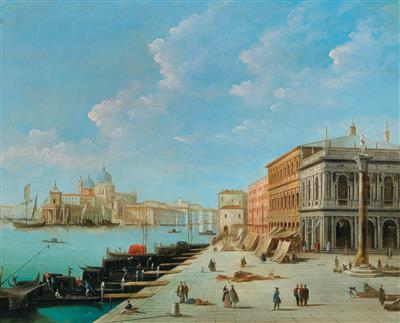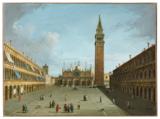Giuseppe Bernardino Bison

(Palmanova 1762-1844 Milan)
The Molo, looking towards the Zecca with the column of Saint Teodoro, Venice,
oil on canvas, 59 x 73 cm, framed
The present view derives from a work of the same subject by Canaletto, which belonged first to the dukes of Leeds and then to Luigi Albertini (and is now in the collection of the Castello Sforzesco, Milan); it is the pendant to The Molo looking towards the Riva degli Schiavoni and the Column of San Marco. The two paintings became famous early on thanks to their being engraved by Antonio Visentini, who published them in the second part of his collection of views after Canaletto in 1742: Urbis Venetiarum Prospectus Celebriones.
This composition represents the South side of the Piazzetta di San Marco that faces onto the Grand Canal, where we can see the column of San Teodoro, part of the Biblioteca Marciana and the Zecca next door, while on the left beyond the quay are the Punta della Dogana and the Basilica of Santa Maria della Salute.
The present work captures the carefree climate of a Venetian day, with the descriptive liveliness of the figures and the terse crystalline light of the sky which dialogues with the green tones of the Grand Canal and the lagoon. This view was made famous by the view painters of the eighteenth century and Bison made use of engravings for his representation, as was dictated by academic discipline which prescribed that aspiring artists should exercise on the finest works of the art of the past. For Bison therefore, as an artist engaged in view painting, and the perspective that underpins this discipline, the paintings of Canaletto represented a fundamental point of reference. The painter from Palmanova could replicate these extensive Venetian views with great ability, capturing the breadth of the horizon described in exacting detail with attention to the architectural fabric, while also focusing attention on the episodes of everyday life that animate the city, finely rendered thanks to his distinctive ‘macchiette’ or figures. In the present work that sensitivity for those locations that were most favoured by the painters of the eighteenth century is evident, this sensitivity is also witness to that mid-nineteenth century taste that would generate the myth of Venice. This appearance, combined with a particular firmness in the pictorial deployment of the pigments, allows us to suggest that this work should be dated to the end of the fourth, or beginning of the fifth decade of the nineteenth century, that is during the painter’s final Milanese years.
Giuseppe Bernardino Bison was one of the most interesting artists of that intermediary phase that marked the passage in Venetian culture from the eighteenth into the nineteenth century. He entered the cultural life of Venice while still a youth and attained notable success even as decorator of interiors. However, it was as a landscape and view painter that he gained the greatest acclaim, and so much so that by the beginning of the new century he had a substantial public at Trieste. This city was inhabited then by a wealthy bourgeoisie that was attentive to collecting contemporary art, and especially appreciated Bison for his idiosyncratic and original way of combining those qualities of painting ‘touched’ by the delicacy of eighteenth century art, with a significant revitalisation of the subjects and style, proper to the cultural renewal of the nineteenth century. With these credentials, at an advanced age, he decided to move to Milan in 1831, where he continued to receive acclaim, and he participated in the exhibitions at Brera.
We are grateful to Fabrizio Magani for his help in cataloguing the present painting.
11.12.2018 - 14:00
- Realized price: **
-
EUR 32,772.-
- Estimate:
-
EUR 20,000.- to EUR 30,000.-
Giuseppe Bernardino Bison
(Palmanova 1762-1844 Milan)
The Molo, looking towards the Zecca with the column of Saint Teodoro, Venice,
oil on canvas, 59 x 73 cm, framed
The present view derives from a work of the same subject by Canaletto, which belonged first to the dukes of Leeds and then to Luigi Albertini (and is now in the collection of the Castello Sforzesco, Milan); it is the pendant to The Molo looking towards the Riva degli Schiavoni and the Column of San Marco. The two paintings became famous early on thanks to their being engraved by Antonio Visentini, who published them in the second part of his collection of views after Canaletto in 1742: Urbis Venetiarum Prospectus Celebriones.
This composition represents the South side of the Piazzetta di San Marco that faces onto the Grand Canal, where we can see the column of San Teodoro, part of the Biblioteca Marciana and the Zecca next door, while on the left beyond the quay are the Punta della Dogana and the Basilica of Santa Maria della Salute.
The present work captures the carefree climate of a Venetian day, with the descriptive liveliness of the figures and the terse crystalline light of the sky which dialogues with the green tones of the Grand Canal and the lagoon. This view was made famous by the view painters of the eighteenth century and Bison made use of engravings for his representation, as was dictated by academic discipline which prescribed that aspiring artists should exercise on the finest works of the art of the past. For Bison therefore, as an artist engaged in view painting, and the perspective that underpins this discipline, the paintings of Canaletto represented a fundamental point of reference. The painter from Palmanova could replicate these extensive Venetian views with great ability, capturing the breadth of the horizon described in exacting detail with attention to the architectural fabric, while also focusing attention on the episodes of everyday life that animate the city, finely rendered thanks to his distinctive ‘macchiette’ or figures. In the present work that sensitivity for those locations that were most favoured by the painters of the eighteenth century is evident, this sensitivity is also witness to that mid-nineteenth century taste that would generate the myth of Venice. This appearance, combined with a particular firmness in the pictorial deployment of the pigments, allows us to suggest that this work should be dated to the end of the fourth, or beginning of the fifth decade of the nineteenth century, that is during the painter’s final Milanese years.
Giuseppe Bernardino Bison was one of the most interesting artists of that intermediary phase that marked the passage in Venetian culture from the eighteenth into the nineteenth century. He entered the cultural life of Venice while still a youth and attained notable success even as decorator of interiors. However, it was as a landscape and view painter that he gained the greatest acclaim, and so much so that by the beginning of the new century he had a substantial public at Trieste. This city was inhabited then by a wealthy bourgeoisie that was attentive to collecting contemporary art, and especially appreciated Bison for his idiosyncratic and original way of combining those qualities of painting ‘touched’ by the delicacy of eighteenth century art, with a significant revitalisation of the subjects and style, proper to the cultural renewal of the nineteenth century. With these credentials, at an advanced age, he decided to move to Milan in 1831, where he continued to receive acclaim, and he participated in the exhibitions at Brera.
We are grateful to Fabrizio Magani for his help in cataloguing the present painting.
|
Buyers hotline
Mon.-Fri.: 10.00am - 5.00pm
old.masters@dorotheum.at +43 1 515 60 403 |
| Auction: | Old Master Paintings |
| Auction type: | Saleroom auction |
| Date: | 11.12.2018 - 14:00 |
| Location: | Vienna | Palais Dorotheum |
| Exhibition: | 06.12. - 11.12.2018 |
** Purchase price incl. charges and taxes(Country of delivery: Austria)
It is not possible to turn in online buying orders anymore. The auction is in preparation or has been executed already.
More objects by this artist
-

Estimate:
EUR 50,000.- to EUR 70,000.- -

Estimate:
EUR 25,000.- to EUR 30,000.-
